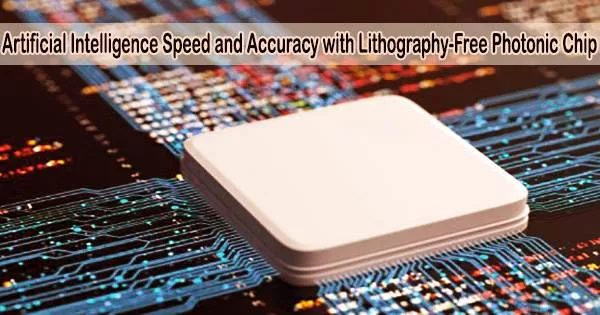Photonic chips, also known as photonic integrated circuits (PICs), are integrated circuits that use light rather than electricity to transmit and process information. They are similar in function to electronic integrated circuits, but instead of using electrons to carry information, they use photons.
Photonic chips have revolutionized data-heavy technologies. These laser-powered devices send and analyze information at the speed of light, making them a viable answer for artificial intelligence’s data-hungry applications whether used alone or in conjunction with conventional electrical circuits.
Photonic circuits consume a lot less energy than electronic ones and have an unmatched speed. While photons travel without losing energy and produce no heat at all, electrons move very slowly through circuitry and collide with other particles. Integrated photonics are ready to take the lead in sustainable computing since they are not constrained by the energy loss present in electronics.
Electronics and photonics use different architectural frameworks and draw on different fields of study. However, both use lithography to specify their circuit components and connect them in a particular order.
Even though photonic chips don’t use the transistors that fill the progressively smaller and more layered grooves of electronic chips, their intricate lithographic patterning directs laser beams via a coherent circuit to create a photonic network that can execute computing algorithms.
But now, for the first time, researchers at the University of Pennsylvania School of Engineering and Applied Science have created a photonic device that provides programmable on-chip information processing without lithography, offering the speed of photonics augmented by superior accuracy and flexibility for AI applications.
The interesting part is how we are controlling the light. Conventional photonic chips are technologies based on passive material, meaning its material scatters light, bouncing it back and forth. Our material is active. The beam of pumping light modifies the material such that when the signal beam arrives, it can release energy and increase the amplitude of signals.
Marco Menarini
This gadget consists of spatially distributed optical gain and loss to achieve unmatched light control. Without the requirement for predetermined lithographic routes, lasers shine light directly onto a semiconductor wafer.
Liang Feng, Professor in the Departments of Materials Science and Engineering (MSE) and Electrical Systems and Engineering (ESE), along with Ph.D. student Tianwei Wu (MSE) and postdoctoral fellows Zihe Gao and Marco Menarini (ESE), introduced the microchip in a recent study published in Nature Photonics.
Silicon-based electronic systems have transformed the computational landscape. But they have clear limitations: they are slow in processing signals, they work through data serially and not in parallel, and they can only be miniaturized to a certain extent. Photonics is one of the most promising alternatives because it can overcome all these shortcomings.
“But photonic chips intended for machine learning applications face the obstacles of an intricate fabrication process where lithographic patterning is fixed, limited in reprogrammability, subject to error or damage, and expensive,” says Feng. “By removing the need for lithography, we are creating a new paradigm. Our chip overcomes those obstacles and offers improved accuracy and ultimate reconfigurability given the elimination of all kinds of constraints from predefined features.”
Without lithography, these chips become adaptable data-processing powerhouses. Because patterns are not pre-defined and etched in, the device is intrinsically free of defects. Perhaps more impressively, the lack of lithography renders the microchip impressively reprogrammable, able to tailor its laser-cast patterns for optimal performance, be the task simple (few inputs, small datasets) or complex (many inputs, large datasets).
In other words, the device’s complexity or minimalism is akin to a living creature that can adapt in a way that an etched microchip cannot.
“What we have here is something incredibly simple,” says Wu. “We can build and use it very quickly. We can integrate it easily with classical electronics. And we can reprogram it, changing the laser patterns on the fly to achieve real-time reconfigurable computing for on-chip training of an AI network.”
An unassuming slab of semiconductor, the device couldn’t be simpler. The manipulation of this slab’s material properties is the key to the research team’s breakthrough in projecting lasers into dynamically programmable patterns to reconfigure the computing functions of the photonic information processor.
This ultimate reconfigurability is critical for real-time machine learning and AI.
“The interesting part,” says Menarini, “is how we are controlling the light. Conventional photonic chips are technologies based on passive material, meaning its material scatters light, bouncing it back and forth. Our material is active. The beam of pumping light modifies the material such that when the signal beam arrives, it can release energy and increase the amplitude of signals.”
“This active nature is the key to this science, and the solution required to achieve our lithography-free technology,” adds Gao. “We can use it to reroute optical signals and program optical information processing on-chip.”
Feng compares the technology to an artistic tool, a pen for drawing pictures on a blank page.
“What we have achieved is exactly the same: pumping light is our pen to draw the photonic computational network (the picture) on a piece of unpatterned semiconductor wafer (the blank page).”
These light beams can be drawn and redone, tracing countless courses into the future, unlike permanent lines of ink.





